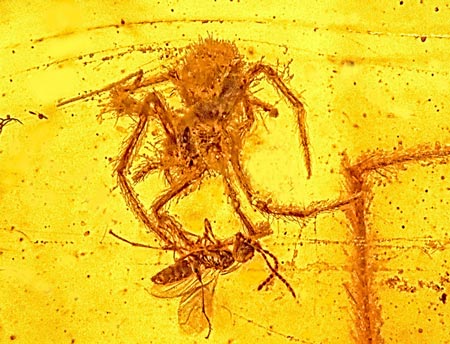Researchers Conclude that “Jurassic Park Scenario” Not Likely
The title of the next instalment of the “Jurassic Park” movie franchise may have just been announced (Jurassic World), but for one group of Manchester University academics it is finally time to pour cold water on the idea that dinosaurs could be cloned from DNA recovered from blood-sucking insects that had been found in amber. Research carried in the early 1990s suggested that minute amounts of DNA could be recovered from insects that had been preserved trapped in tree resin (amber).
However, new research published in the online journal “Public Library of Science – Biology”, which used the very latest DNA recovery techniques, casts doubt on the ability to extract DNA from such a source.
The Existence of DNA in Fossils Unlikely
Researchers from the Faculty of Life Sciences at The University of Manchester can now confirm that the existence of DNA in amber fossils is highly unlikely. The team led by amber expert Dr David Penney and co-ordinated by ancient DNA expert Professor Terry Brown used highly-sensitive “next generation” sequencing techniques, the most advance type of DNA sequencing, on insects in copal, the sub-fossilised resin precursor of amber.
Ancient Insects Preserved in Amber
The research was conducted wearing full forensic suits in the dedicated ancient DNA facility at The University of Manchester, which comprises a suite of independent, physically isolated laboratories, each with an ultra-filtered air supply maintaining positive displacement pressure and a managed access system.
According to Professor Brown:
“In the original 1990s studies DNA amplification was achieved by a process called the polymerase chain reaction (PCR), which will preferentially amplify any modern, undamaged DNA molecules that contaminate an extract of partially degraded ancient ones to give false positive results that might be mistaken for genuine ancient DNA. Our approach, using “next generation” sequencing methods is ideal for ancient DNA because it provides sequences for all the DNA molecules in an extract, regardless of their length, and is less likely to give preference to contaminating modern molecules.”
Cloning Dinosaurs
The team concluded that their inability to detect ancient DNA in relatively young (60 years to 10,600 years old) sub-fossilised insects in copal, despite using sensitive next generation methods, suggests that the potential for DNA survival in resin inclusions is no better, and perhaps worse, than that in air-dried museum insects (from which DNA has been retrieved using similar techniques). This raises significant doubts about claims of DNA extraction from fossil insects in amber, many millions of years older than the copal specimens.
Dr Penney added:
“Intuitively, one might imagine that the complete and rapid engulfment in resin, resulting in almost instantaneous demise, might promote the preservation of DNA in a resin entombed insect, but this appears not to be the case. So, unfortunately, the Jurassic Park scenario must remain in the realms of fiction.”
Everything Dinosaur acknowledges the contribution of Manchester University in compiling this article.
Visit Everything Dinosaurs award-winning website for dinosaur models, toys and games: Everything Dinosaur – Dinosaur Models, Toys and Games.






Leave A Comment